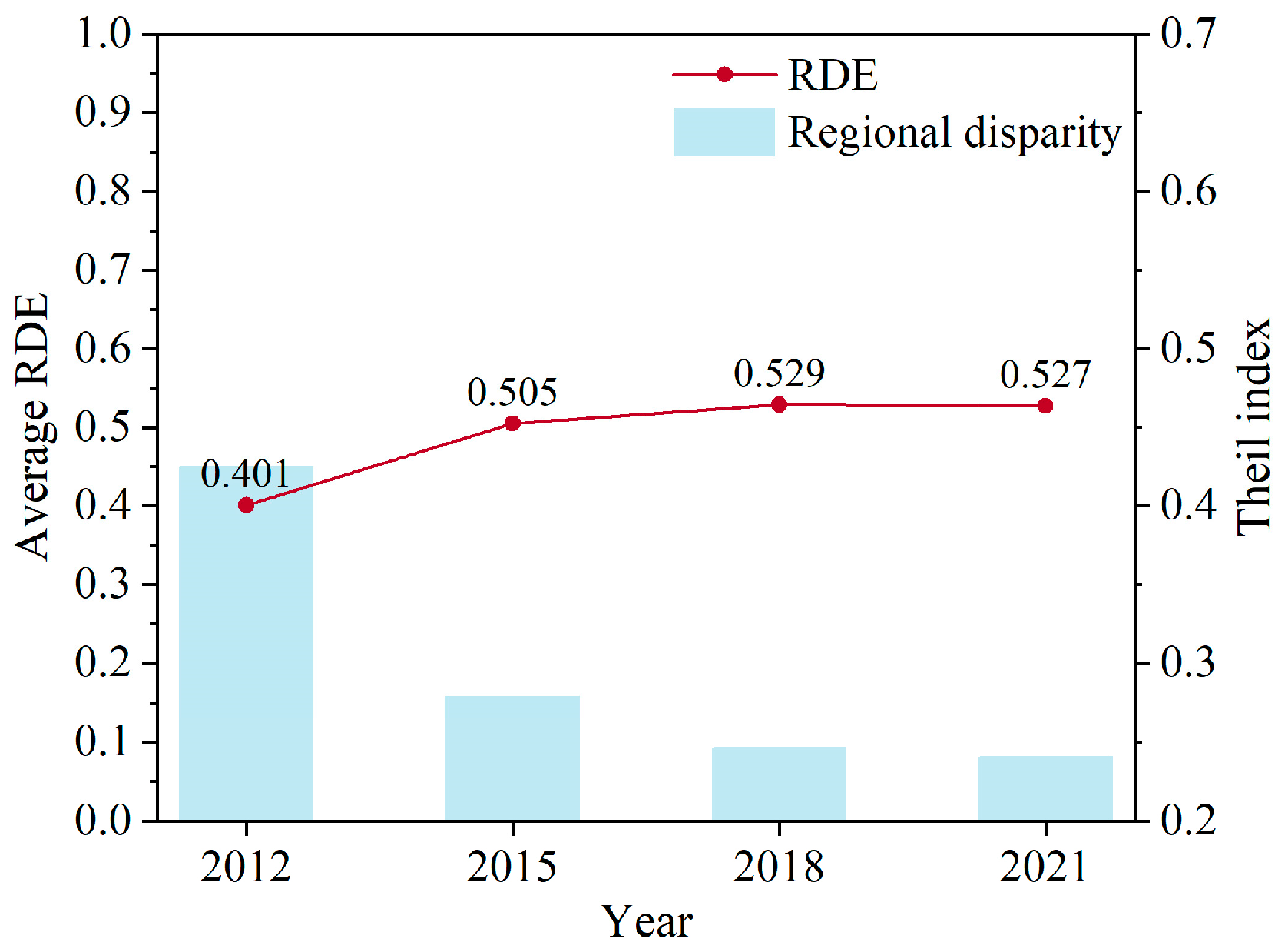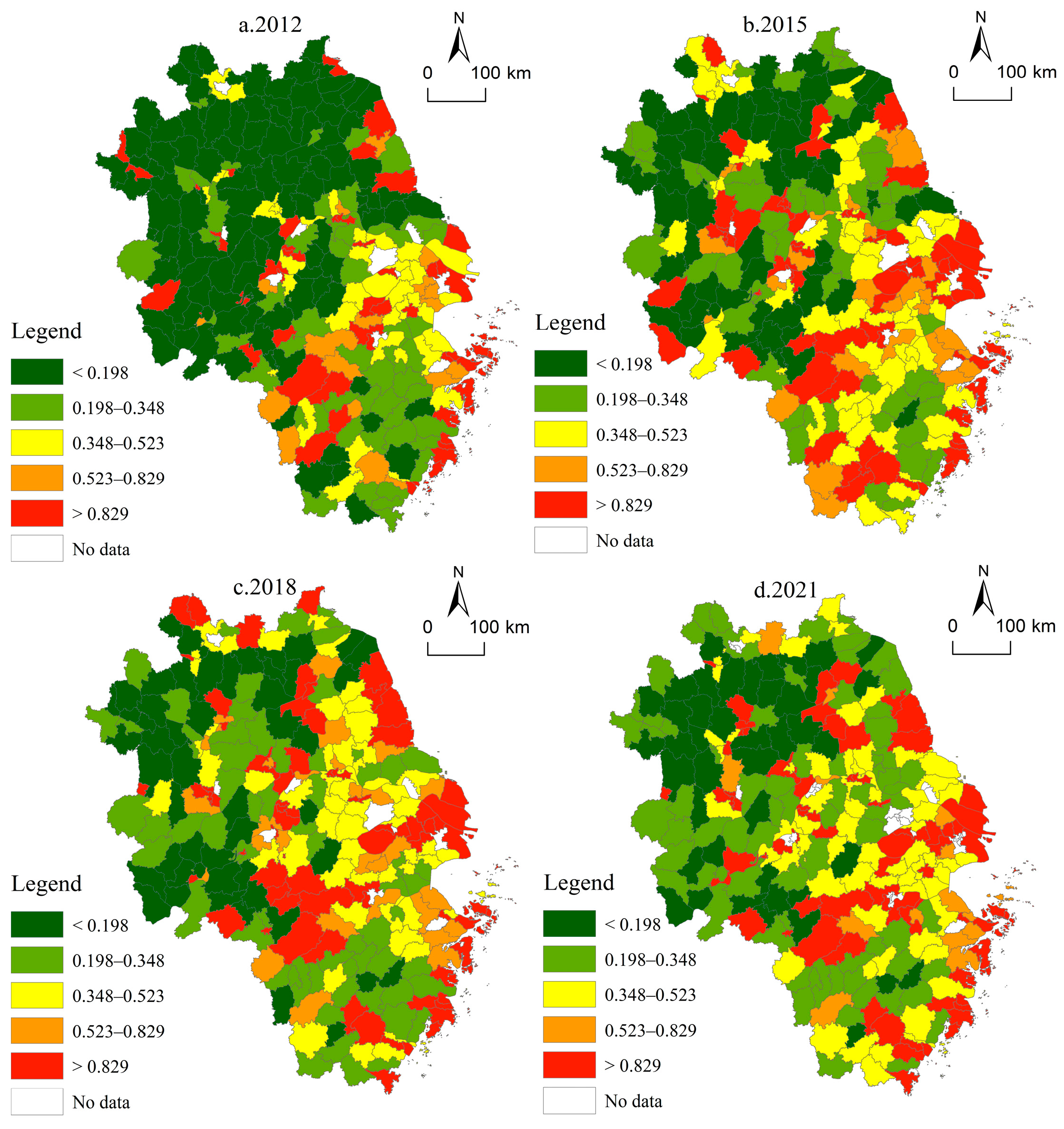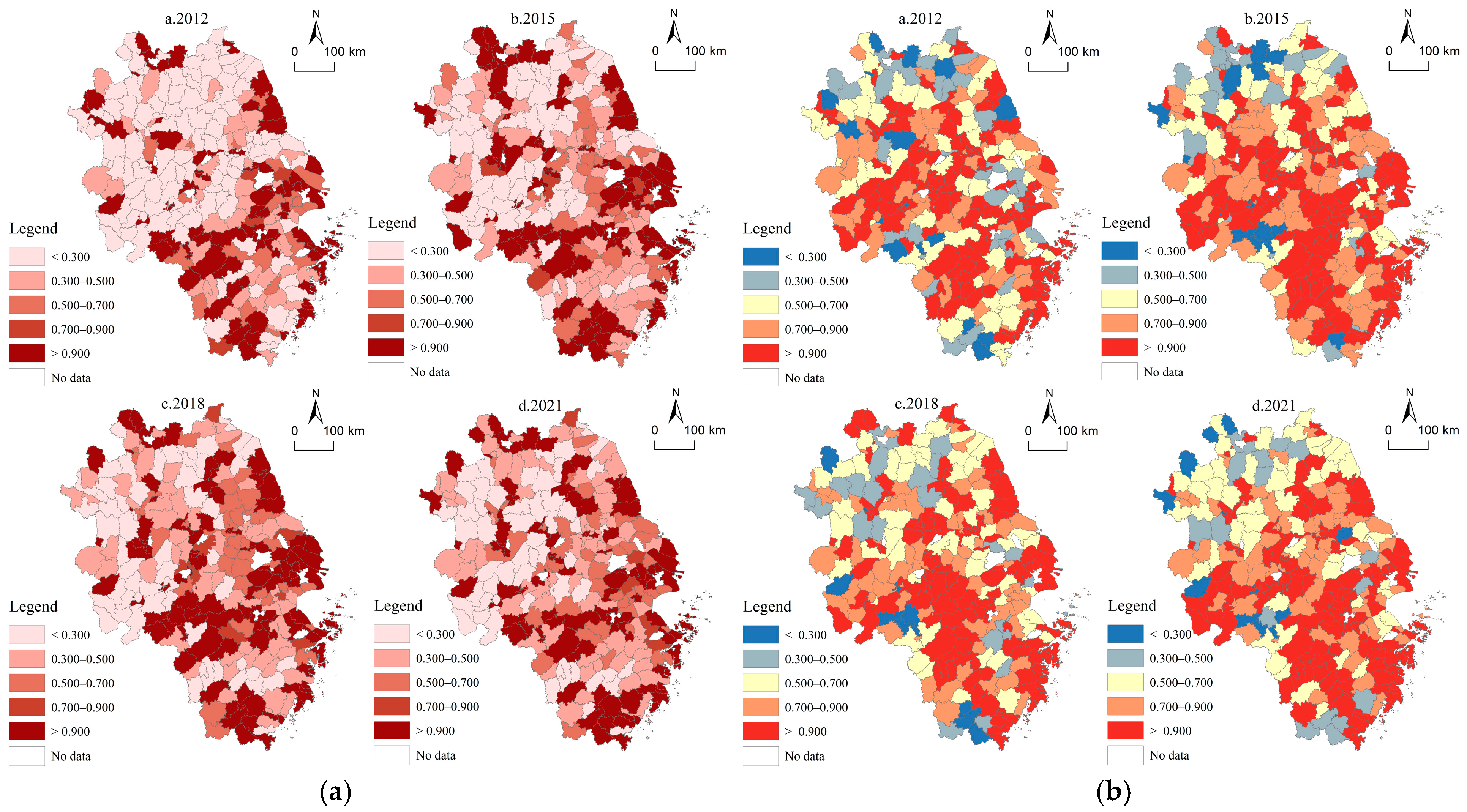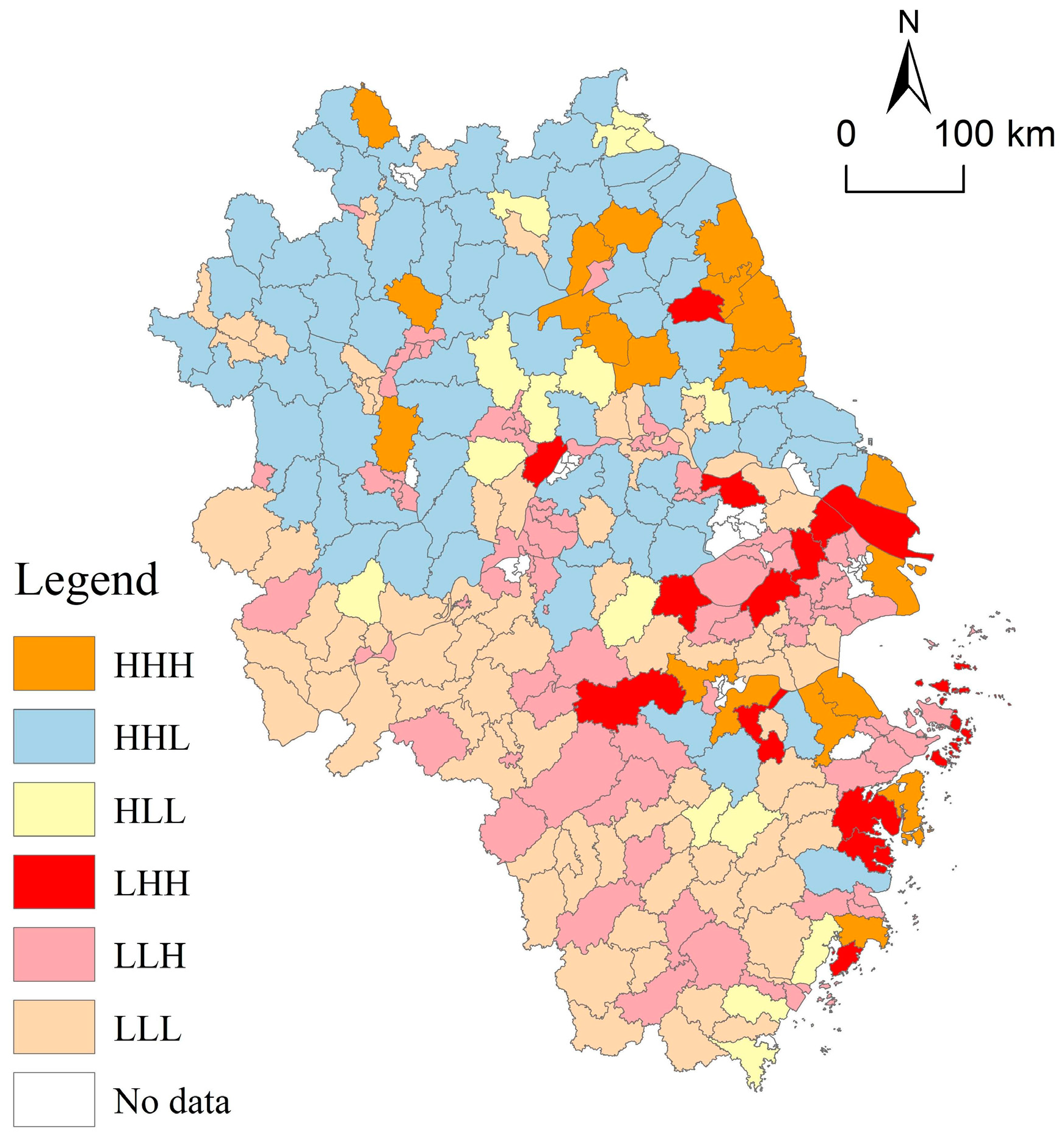A Spatiotemporal Evolution and Pathway Analysis of Rural Development Efficiency: A Case Study of the Yangtze River Delta
Abstract
:1. Introduction
2. Methods and Data Sources
2.1. Research Framework
2.2. Overview of the Study Area
2.3. Research Methodology
2.3.1. Super-SBM Model with Undesirable Outputs
2.3.2. Theil Index
2.3.3. Spatial Markov Chain
2.4. Construction of the Index System and Data Sources
2.4.1. Construction of the Index System
2.4.2. Data Sources
3. Results
3.1. Temporal Evolution Characteristics of RDE
3.2. Spatial Differentiation Characteristics of RDE
3.2.1. Overall Distribution Characteristics
3.2.2. Characteristics of Decomposed Efficiency Distribution
3.2.3. Regional Disparity Characteristics
3.3. Spatial Evolution Characteristics of RDE
3.4. Classification of Rural Development Types
4. Discussion
4.1. Characteristics of RDE
4.2. Policy Implications
5. Conclusions
Author Contributions
Funding
Institutional Review Board Statement
Informed Consent Statement
Data Availability Statement
Acknowledgments
Conflicts of Interest
References
- Shen, M.; Shen, J. State-led commodification of rural China and the sustainable provision of public goods in question: A case study of Tangjiajia, Nanjing. J. Rural Stud. 2022, 93, 449–460. [Google Scholar] [CrossRef]
- Yang, G.; Zhuang, H.; Tian, G.; Miao, G. The Logic of Realizing Endogeous Sustainable Development of Rural Economy: An Experience Inspecton Based on Z Town in Jiangsu Province. Issues Agric. Econ. 2023, 6, 121–134. [Google Scholar] [CrossRef]
- Ayenew, H.Y.; Estruch, E.; Sauer, J.; Abate-Kassa, G.; Schickramm, L.; Wobst, P. Decent rural employment and farm production efficiency: Empirical evidence from Tanzania and Ethiopia. Agric. Econ. 2017, 48, 587–596. [Google Scholar] [CrossRef]
- Farrell, M.J. The measurement of productive efficiency. J. R. Stat. Soc. 1957, 120, 253–278. [Google Scholar] [CrossRef]
- Picazo-Tadeo, A.J.; Gómez-Limón, J.A.; Reig-Martínez, E. Assessing farming eco-efficiency: A data envelopment analysis approach. J. Environ. Manag. 2011, 92, 1154–1164. [Google Scholar] [CrossRef] [PubMed]
- Drall, A.; Mandal, S.K. Non-farm income and environmental efficiency of the farmers: Evidence from India. Heliyon 2024, 10, e30804. [Google Scholar] [CrossRef] [PubMed]
- Li, T.; Liu, J.; Zhu, H.; Zhang, S. Business characteristics and efficiency of rural tourism enterprises: An empirical study from China. Asia Pac. J. Tour. Res. 2018, 23, 549–559. [Google Scholar] [CrossRef]
- Walker, N.L.; Norton, A.; Harris, I.; Williams, A.P.; Styles, D. Economic and environmental efficiency of UK and Ireland water companies: Influence of exogenous factors and rurality. J. Environ. Manag. 2019, 241, 363–373. [Google Scholar] [CrossRef] [PubMed]
- Stępień, S.; Czyżewski, B.; Sapa, A.; Borychowski, M.; Poczta, W.; Poczta-Wajda, A. Eco-efficiency of small-scale farming in Poland and its institutional drivers. J. Clean. Prod. 2021, 279, 123721. [Google Scholar] [CrossRef]
- Zhang, Q.; Qu, Y.; Zhan, L. Great transition and new pattern: Agriculture and rural area green development and its coordinated relationship with economic growth in China. J. Environ. Manag. 2023, 344, 118563. [Google Scholar] [CrossRef]
- Hou, M.; Yao, S. Spatial-temporal evolution and trend prediction of agricultural eco-efficiency in China: 1978–2016. Acta Geogr. Sin. 2018, 73, 2168–2183. [Google Scholar] [CrossRef]
- Long, H.; Zou, J.; Liu, Y. Differentiation of rural development driven by industrialization and urbanization in eastern coastal China. Habitat Int. 2009, 33, 454–462. [Google Scholar] [CrossRef]
- Wu, Q.; Ye, J.; Chen, Y. The spatial differentiation of rurality in developed coastal regions of eastern China based on rural revitalization: The case of Zhejiang Province. Sci. Geogr. Sin. 2022, 42, 466–475. [Google Scholar] [CrossRef]
- Jiang, Y.; Pan, Z.; Pan, M. Spatial variation and strategic pattern optimization of operation efficiency of rural tourism in Chongqing. Resour. Sci. 2016, 38, 2181–2191. [Google Scholar] [CrossRef]
- Forleo, M.B.; Giaccio, V.; Mastronardi, L.; Romagnoli, L. Analysing the efficiency of diversified farms: Evidences from Italian FADN data. J. Rural Stud. 2021, 82, 262–270. [Google Scholar] [CrossRef]
- Yang, Y.; Ma, H.; Wu, G. Agricultural green total factor productivity under the distortion of the factor market in China. Sustainability 2022, 14, 9309. [Google Scholar] [CrossRef]
- Mergoni, A.; Dipierro, A.R.; Colamartino, C. European agricultural sector: The tortuous path across efficiency, sustainability and environmental risk. Socio-Econ. Plan. Sci. 2024, 92, 101848. [Google Scholar] [CrossRef]
- Xiao, P.; Xu, J.; Yu, Z.; Qian, P.; Lu, M.; Ma, C. Spatiotemporal pattern differentiation and influencing factors of cultivated land use efficiency in Hubei Province under carbon emission constraints. Sustainability 2022, 14, 7042. [Google Scholar] [CrossRef]
- Lobley, M.; Potter, C. Agricultural change and restructuring: Recent evidence from a survey of agricultural households in England. J. Rural Stud. 2004, 20, 499–510. [Google Scholar] [CrossRef]
- Tobler, W.R. A computer movie simulating urban growth in the Detroit Region. Econ. Geogr. 1970, 46, 234–240. [Google Scholar] [CrossRef]
- Tone, K. A slacks-based measure of efficiency in data envelopment analysis. Eur. J. Oper. Res. 2001, 130, 498–509. [Google Scholar] [CrossRef]
- Zhang, W.; Bao, S. Created unequal: China’s regional pay inequality and its relationship with mega-trend urbanization. Appl. Geogr. 2015, 61, 81–93. [Google Scholar] [CrossRef]
- Le Gallo, J. Space-time analysis of GDP disparities among European regions: A Markov chains approach. Int. Reg. Sci. Rev. 2004, 27, 138–163. [Google Scholar] [CrossRef]
- Wei, Y.; Liao, F. Dynamics, space, and regional inequality in provincial China: A case study of Guangdong province. Appl. Geogr. 2012, 35, 71–83. [Google Scholar] [CrossRef]
- Rey, S.J.; Montouri, B.D. US regional income convergence: A spatial econometric perspective. Reg. Stud. 1999, 33, 143–156. [Google Scholar] [CrossRef]
- Liu, Y.; Zhou, Y.; Li, Y. Rural regional system and rural revitalization strategy in China. Acta Geogr. Sin. 2019, 74, 2511–2528. [Google Scholar]
- Zhang, Z.; Liao, X.; Li, C.; Yang, C.; Yang, S.; Li, S. Spatio-temporal characteristics of agricultural eco-efficiency and its determinants in Hunan Province. Econ. Geogr. 2022, 42, 181–189. [Google Scholar] [CrossRef]
- Tian, Y.; Huang, J.; An, M. Evaluation on the efficiency of agricultural modernization under the rural revitalization strategy: Based on the combined analysis of Super-efficiency DEA and comprehensive entropy method. Issues Agric. Econ. 2021, 3, 100–113. [Google Scholar] [CrossRef]
- Jiang, P.; Yang, Y.; Hao, L. Study on rural tourism in the outer suburban areas of beijing: Efficiency evaluation and its influency factors. Chin. J. Agric. Resour. Reg. Plan. 2023, 44, 198–205. [Google Scholar]
- Ma, W.; Liu, T.; Li, W.; Yang, H. The role of agricultural machinery in improving green grain productivity in China: Towards trans-regional operation and low-carbon practices. Heliyon 2023, 9, e20279. [Google Scholar] [CrossRef]
- Khurana, T.; Sangita, S. Household access to electricity and non-farm business in rural India: A panel data analysis. Energy Sustain. Dev. 2022, 67, 125–134. [Google Scholar] [CrossRef]
- Zheng, D.; Hao, S.; Sun, C. Evaluation of Agricultural Ecological Efficiency and Its Spatial- temporal Differentiation Based on DEA-ESDA. Sci. Geogr. Sin. 2018, 38, 419–427. [Google Scholar] [CrossRef]
- Henderson, J.V.; Storeygard, A.; Weil, D.N. Measuring economic growth from outer space. Am. Econ. Rev. 2012, 102, 994–1028. [Google Scholar] [CrossRef]
- Xu, K.; Fang, Y.; Zhou, Y. Spatial differentiation of rural functions from the perspective of production-living-ecological functions at the township level: Acase study of Shandong Province. Prog. Geogr. 2023, 42, 644–656. [Google Scholar] [CrossRef]
- Sun, H.; Liang, H.; Chang, X.; Cui, Q.; Tao, Y. Land use patterns on carbon emission and spatial association in China. Econ. Geogr. 2015, 35, 154–162. [Google Scholar] [CrossRef]
- Yang, K.; Zhang, Y.; Zhao, X.; Wen, Q.; Zhong, T. Temporal and spatial characteristics and influencing factors of structural efficiency of rural land use. Prog. Geogr. 2019, 38, 1393–1402. [Google Scholar] [CrossRef]
- Chen, Z.; Yu, B.; Yang, C.; Zhou, Y.; Qian, X.; Wang, C.; Wu, B.; Wu, J. An extended time-series (2000–2018) of global NPP-VIIRS-like nighttime light data from a cross-sensor calibration. Earth Syst. Sci. Data Discuss. 2020, 2020, 1–34. [Google Scholar] [CrossRef]
- Han, Z.; Cao, X.; Di, G. Spatial-temporal evolution of infrastructure investment efficiency and its correlation pattern based on the empirical study of prefecture-level cities in China. Sci. Geogr. Sin. 2021, 41, 941–950. [Google Scholar] [CrossRef]
- Long, H.; Liu, Y.; Zou, J. Assessment of Rural Development Types and Their Rurality in Eastern Coastal China. Acta Geogr. Sin. 2009, 64, 426–434. [Google Scholar]
- Shi, Z.; Wang, R. Research on the coupling coordination relationship between agricultural. J. Arid Land Resour. Environ. 2024, 38, 1–12. [Google Scholar] [CrossRef]
- Tian, M.; Huang, Y.; Wang, F.; Liu, Y.; Liu, C.; Meng, X. The Threshold Effect of Rural Tourism in Poverty Reduction in Underdeveloped Areas: Based on Panel Data of 15 Underdeveloped Counties in Anhui Province. For. Econ. 2022, 44, 65–81. [Google Scholar] [CrossRef]
- Cao, F.; Hang, Z.; Xu, M.; Wang, K. Spatial-temporal pattern and influencing factors of tourism efficiency and the decomposition efficiency in Chinese scenic areas: Based on the Bootstrap-DEA method. Geogr. Res. 2015, 34, 2395–2408. [Google Scholar]
- Meng, W.; Zhang, G.; Zhao, F. Digital Economy Empowers Rural Revitalization: Influencing Mechanisms and Spatial Effects. Res. Financ. Econ. Issues 2023, 3, 32–44. [Google Scholar] [CrossRef]






| Dimensions | Indicators | Indicator Description | Unit |
|---|---|---|---|
| Input | Land input | Rural land area | km2 |
| Labor input | Number of rural employees | People/year | |
| Capital input | Expenditures for agriculture, forestry, and water affairs | CNY 10,000 | |
| Total power of agricultural machinery | 1000 kW | ||
| Rural electricity consumption | 10,000 kWh | ||
| Desirable output | Economic effects | Night light index | / |
| Agricultural, forestry, fishery, and livestock production values | CNY 10,000 | ||
| Social effects | Per capita disposable income of rural permanent residents | CNY | |
| Undesirable output | Environmental pollution | Carbon emissions from land use | 10,000 ton |
| Year | Aggregate Thiel Index | Intraprovincial Theil Index | Interprovincial Theil Index | Intraprovincial Theil Index Decomposition | |||
|---|---|---|---|---|---|---|---|
| Shanghai | Jiangsu | Zhejiang | Anhui | ||||
| 2012 | 0.425 | 0.258 (60.65%) | 0.167 (39.33%) | 0.066 (3.35%) | 0.512 (12.26%) | 0.209 (26.14%) | 0.569 (16.90%) |
| 2015 | 0.279 | 0.148 (53.14%) | 0.131 (46.86%) | 0.385 (3.35%) | 0.299 (14.02%) | 0.146 (19.61%) | 0.376 (16.16%) |
| 2018 | 0.246 | 0.103 (40.80%) | 0.131 (58.20%) | 0.093 (2.12%) | 0.209 (12.93%) | 0.177 (13.79%) | 0.338 (12.97%) |
| 2021 | 0.241 | 0.094 (39.06%) | 0.147 (60.94%) | 0.073 (2.03%) | 0.227 (10.66%) | 0.159 (14.16%) | 0.317 (12.14%) |
| t/t + 1 | n | 1 | 2 | 3 | 4 | 5 |
|---|---|---|---|---|---|---|
| 1 | 225 | 0.604 | 0.267 | 0.058 | 0.009 | 0.062 |
| 2 | 117 | 0.079 | 0.520 | 0.328 | 0.028 | 0.045 |
| 3 | 151 | 0.007 | 0.205 | 0.517 | 0.146 | 0.126 |
| 4 | 74 | 0.000 | 0.041 | 0.284 | 0.392 | 0.283 |
| 5 | 192 | 0.031 | 0.068 | 0.052 | 0.063 | 0.786 |
| Neighborhood Type | t/t + 1 | n | 1 | 2 | 3 | 4 | 5 |
|---|---|---|---|---|---|---|---|
| 1 | 1 | 88 | 0.659 | 0.205 | 0.091 | 0.000 | 0.045 |
| 2 | 21 | 0.286 | 0.429 | 0.238 | 0.000 | 0.048 | |
| 3 | 7 | 0.000 | 0.000 | 0.714 | 0.143 | 0.143 | |
| 4 | 1 | 0.000 | 0.000 | 0.000 | 0.000 | 1.000 | |
| 5 | 11 | 0.182 | 0.455 | 0.000 | 0.000 | 0.364 | |
| 2 | 1 | 68 | 0.471 | 0.368 | 0.044 | 0.015 | 0.103 |
| 2 | 61 | 0.066 | 0.525 | 0.328 | 0.033 | 0.049 | |
| 3 | 17 | 0.000 | 0.353 | 0.235 | 0.118 | 0.294 | |
| 4 | 2 | 0.000 | 0.000 | 0.000 | 0.500 | 0.500 | |
| 5 | 21 | 0.000 | 0.048 | 0.048 | 0.048 | 0.857 | |
| 3 | 1 | 55 | 0.709 | 0.218 | 0.036 | 0.018 | 0.018 |
| 2 | 49 | 0.020 | 0.531 | 0.347 | 0.041 | 0.061 | |
| 3 | 52 | 0.019 | 0.231 | 0.519 | 0.135 | 0.096 | |
| 4 | 22 | 0.000 | 0.045 | 0.227 | 0.364 | 0.364 | |
| 5 | 38 | 0.000 | 0.053 | 0.053 | 0.079 | 0.816 | |
| 4 | 1 | 11 | 0.455 | 0.455 | 0.000 | 0.000 | 0.091 |
| 2 | 45 | 0.067 | 0.533 | 0.356 | 0.022 | 0.022 | |
| 3 | 67 | 0.000 | 0.194 | 0.552 | 0.134 | 0.119 | |
| 4 | 41 | 0.000 | 0.049 | 0.341 | 0.390 | 0.220 | |
| 5 | 81 | 0.012 | 0.062 | 0.062 | 0.074 | 0.790 | |
| 5 | 1 | 0 | 0.000 | 0.000 | 0.000 | 0.000 | 0.000 |
| 2 | 1 | 0.000 | 1.000 | 0.000 | 0.000 | 0.000 | |
| 3 | 6 | 0.000 | 0.000 | 0.667 | 0.333 | 0.000 | |
| 4 | 6 | 0.000 | 0.000 | 0.333 | 0.500 | 0.167 | |
| 5 | 33 | 0.000 | 0.000 | 0.030 | 0.061 | 0.909 |
| Dimensions | Indicators | Indicator Description | Index Weight |
|---|---|---|---|
| Input | Land input | Rural land area (km2) | 0.151 |
| Labor input | Number of rural employees (people/year) | 0.135 | |
| Capital input | Expenditures for agriculture, forestry, and water affairs (CNY 10,000) | 0146 | |
| Total power of agricultural machinery (1000 kW) | 0.246 | ||
| Rural electricity consumption (10,000 kWh) | 0.323 | ||
| Desirable output | Economic effects | Night light index | 0.527 |
| Agricultural, forestry, fishery, and livestock production values (CNY 10,000) | 0.300 | ||
| Social effects | Per capita disposable income of rural permanent residents (CNY) | 0.144 | |
| Undesirable output | Environmental pollution | Carbon emissions from land use (10,000 tons) | 0.294 |
Disclaimer/Publisher’s Note: The statements, opinions and data contained in all publications are solely those of the individual author(s) and contributor(s) and not of MDPI and/or the editor(s). MDPI and/or the editor(s) disclaim responsibility for any injury to people or property resulting from any ideas, methods, instructions or products referred to in the content. |
© 2024 by the authors. Licensee MDPI, Basel, Switzerland. This article is an open access article distributed under the terms and conditions of the Creative Commons Attribution (CC BY) license (https://creativecommons.org/licenses/by/4.0/).
Share and Cite
Wu, Y.; Chen, X. A Spatiotemporal Evolution and Pathway Analysis of Rural Development Efficiency: A Case Study of the Yangtze River Delta. Sustainability 2024, 16, 6543. https://doi.org/10.3390/su16156543
Wu Y, Chen X. A Spatiotemporal Evolution and Pathway Analysis of Rural Development Efficiency: A Case Study of the Yangtze River Delta. Sustainability. 2024; 16(15):6543. https://doi.org/10.3390/su16156543
Chicago/Turabian StyleWu, Yizhou, and Xiaomin Chen. 2024. "A Spatiotemporal Evolution and Pathway Analysis of Rural Development Efficiency: A Case Study of the Yangtze River Delta" Sustainability 16, no. 15: 6543. https://doi.org/10.3390/su16156543





